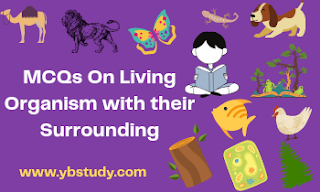Living organisms and their Surroundings Class 6 MCQ with Answers
Multiple Choice questions on Living organisms and their Surroundings Class 6 MCQ
Hello Students, how are you all hope you all will be good, in this Page we have shared with you more than 20 Important MCQ on Living organisms and their Surroundings Class 6 with answers which is helpful for various entrance exams preparation. This MCQ pdf will help you enhance your performance in entrance exams. Living organisms and their Surroundings Class 6 MCQ online test is important for Class 6 Students.
Living organisms and their Surroundings Class 6 MCQ questions and answers are provided here with answers and detailed explanation each question. These MCQs are important for various type of exam. By practicing our MCQ on Living organisms and their Surroundings Class 6 pdf students will get acquainted with the key concepts which must be prepared to score high marks in the objective type questions in the any exam.
Important points about living organisms and their surroundings.
- Growth, respiration, excretion, reproduction, responsiveness to stimuli, movement, a definite lifespan and a cellular structure are the characteristics of living things.
- Animals grow for certain period of their life. Plants, however, grow as long as they live.
- Animals have specific organs for respiration, while plants respire through microscopic pores on their leaves and stems.
- The process of eliminating waste products from the body is called excretion.
- All living things have the ability to reproduce.
- Living things move because of their ability to respond to stimuli.
- Plants show spontaneous movements but they cannot leave their place and go elsewhere as animals do.
- Living things have a definite lifespan at the end of which they die.
- Many animals and plants are useful to us in our daily life. Some animals and plants can be harmful to us.
- The smallest unit of a living thing is the cell.
MCQs On Living organisms and their Surroundings Class 6
1. Animals and plants have certain features which make them to survive in a particular habitat. This is called________
A) adaptation
B) speciation
C) specialisation
D) evolution
Answer: A
2. Which is an aquatic adaptation?
A) Streamlined body
B) Light and hollow bones
C) Hair on body
D) Gills
Answer: A
3. Living things need energy to_______
A) grow
B) play
C) exercise
D) all of these
Answer: D
4. Which of the following is not the characteristic of a living thing?
A) Growth
B) Movement
C) Do not need food
D) Respiration
Answer: C
5. Fishes move about in the water with the help of their_______
A) mouths and gills
B) legs and scale
C) wings and tails
D) fins and tails
Answer: D
6. What is the correct sequence?
A) Genus-species-order-kingdom
B) Species-order-phylum-kingdom
C) Species-genus-order-phylum
D) Kingdom-phylum-class-order
Answer: D
7. The defining characteristic of living beings is___________
A) They reproduce
B) They can digest their food
C) They respond to external stimuli
D) They regenerate
Answer: C
8. The scientific name of mango is_______
A) Mangifera indica
B) Mangifera Indica
C) Mangifera indica
D) Mangifera Indica
Answer: C
9. Which Of The Following Is Correct For Respiration In Plants?
A) Respiration take place only during daytime
B) Respiration takes place only during night
C) Respiration take place both during day and night
D) Respiration take place only when plants are not making food
Answer: C
10. Choose The Set That Represents Only The Biotic Components Of A Habitat
A) Tiger, deer, grass, soil
B) Rocks, soil, plants, air
C) Sand, turtle, crab, rocks
D) Aquatic plant, fish, frog, insect
Answer: D
11. Supriya Is Writing Some Statements, Choose The Incorrect Statement And Help Him
A) The plants can move only parts of their body such as leaves, flowers, shoots and roots.
B) In living things, movement is caused by internal factors such as muscles pulling on bones, contraction and relaxation of only muscles or by action of chemicals called hormones.
C) The movement in non-living things is caused by an external force such as the push of our hand, blowing air or wind, flowing water or hot and compressed gases.
D) None of the above
Answer: D
12.The removal of waste substances from the body is called__________
A) reproduction
B) respiration
C) breathing
D) excretion
Answer: D
13._________ is the structural and functional unit of all living things.
A) Matter
B) Cell
C) Organs
D) Tissue
Answer: B
14. Which of the following aquatic plants grows completely submerged in water?
A) Water hyacinth
B) Hydrilla
C) Water lily
D) Lotus
Answer: B
15. Choose incorrect statements________
A) Every leaf of a plant has a large number of tiny pores or holes called stomata on its surface.
B) The exchange of gases oxygen and carbon dioxide in plants during respiration take place through the tiny pores.
C) The carbon dioxide produced during respiration is also uses by the body of the earthworm.
D) The plants give out carbon dioxide, produced in respiration only at night time.
Answer: C
16. Earthworms Breathe Through Their_____________
A) Skin
B) Gills
C) Lungs
D) Stomata
Answer: A
17. The body structure of camel which help them to survive__________
A) snowy
B) desert
C) hilly region
D) forest
Answer: B
18. The slippery scales help the fish in _____
A) Eating
B) breathing
C) swimming
D) none of these
Answer: C
19. Sunken stomata are present in________
A) hydrophytes
B) epiphytes
C) xerophytes
D) mesophytes
Answer: C
20. Which one of these animals can live on land as well as in water?
A) Deer
B) Giraffe
C) Frog
D) Fox
Answer: C

